As one of the cities with the richest tourism resources in China, Chongqing is listed among the “World Top 10 Destinations 2012” on the website of Frommer's, a famous American travel guidebook. It now has 136 tourist attractions that reach level A, among which there are 6 5A tourist attractions, 48 4A tourist attractions and 46 3A tourist attractions; Chongqing also has 1 World Natural Heritage site and 1 World Cultural Heritage site. Among the well-known tourist attractions, there are Three Gorges —— the only grand gorge in the world which can be viewed in a luxury cruiser on Yangtze River; Dazu Rock Carvings —— World Cultural Heritage; Wulong Tiansheng Three Bridges —— World Natural Heritage; Tiankeng and Geofracture Scenic Area in Fengjie —— the deepest and longest Tiankeng and geofracture in the world; Hechuan Fishing Town —— relic of ancient battlefield that changed the history of Europe; Fuling Baiheliang —— the only ancient hydrological station that has been preserved completely in the world, to mention only a few. Benefiting from the mountains and water, Chongqing has a diversity of world-class geothermal energy resources of springs, as well as 1,600 years of spring history. In 2012, Chongqing was granted the “World's Hot Spring Capital” in The 65th General Assembly and International Scientific Congress of The World Federation of Hydrotherapy and Climatotherapy.
What’s more, Chongqing also has excellent tourism reception facilities and superior services. There are 266 tourist hotels with star ratings in Chongqing, among which there are 22 five-star hotels, 55 four-star hotels and 136 three-star hotels; Among the 510 travel agencies, 48 are outbound travel agencies; Besides, there are 31 five-star Yangtze River cruisers to meet various needs of tourists from different countries and regions.
Friday, April 25, 2014
Introduction of Chongqing
Chongqing is situated at 105`17'-110`11' E and 28`10'-32`13' N, at the transitional area between the Qinghai-Tibet Plateau and the plain on the middle and lower reaches of the Yangtze River in the sub-tropical climate zone swept by the moist monsoon. The average annual temperature is around 18℃, with the lowest winter temperature averaging between 6℃ and 8℃ and summer temperature averaging between 27℃ and 29℃. It has a total annual sunshine time of 1,000 to 1,200 hours. It has mild winter, hot summers, long frost-free periods and ample rain, as well as warm, wet and cloudy days, with rain and heat occurring in the same season. It has an annual rainfall of 1,000-1,400 mm. It often rains at night in late spring and early summer, and thus the city is famous for its "night rain in the Ba Mountains". The land under Chongqing's jurisdiction is 470 kilometers from east to west, and 450 kilometers from north to south. It borders on Hubei and Hunan provinces in the east, Guizhou in the south, Sichuan in the west and north and Shaanxi Province at its northeast corner.
Chongqing covers a large area crisscrossed by rivers and mountains. The Daba Mountains stand in the north, the Wushan Mountains in the east, the Wuling Mountains in the southeast and the Dalou Mountains in the south. The whole area slopes down from north and south towards the Yangtze valley, with sharp rises and falls. The area is featured by mountain and hills, with large sloping areas at different heights. Typical karst landscape is common in this area, and stone forests, forests of peaks, limestone caves and valleys can be found in many places. The Yangtze River runs through the whole area from west to east, covering a course of 665 kilometers, cutting through the Wushan Mountains at three places and forming the well-known Three Gorges: the Qutang, the Wuxia and the Xiling gorges. Coming from northwest and running through "the Jialing Lesser Three Gorges" of Libi, Wentang and Guanyin, the Jialing River joins the Yangtze in Chongqing.
The central urban area of Chongqing, or Chongqing proper, is a beautiful city with its unique features. Built on mountains and embraced by the Yangtze and Jialing rivers, it is known as a "mountain city" and a "city on rivers". The night scene of the city is very charming, with millions of lights and their reflection on the rivers, forming another Milky Way. With its special topographical features, Chongqing has the unique magnificent scenery of mountain, rivers, forests, springs, waterfalls, gorges and caves. The best natural scenery is found in the Yangtze Three Gorges. High cliffs standing face to face on either side of the Yangtze, forming a natural gallery of arts. Each of the three gorges has its special charm: the Qutang Gorge is imposing and magnificent, the Wuxia Gorge elegant and graceful, and the Xiling Gorge precipitous and perilous. There are the even more beautiful Lesser Three Gorges on the Daning River and the Lesser Lesser Three Gorges on the Madu River. Li Bai (701-762), the great poet of the Tang Dynasty, inspired by the scenery, chanted while touring through the Three Gorges, and left the world an immortal poem: Leaving at dawn the White Emperor crowned with cloud,
I've sailed a thousand li through canyons in a day. With the monkeys' adieus the riverbanks are loud, My skiff has left ten thousand mountains far away.
In addition to the magnificent gorges, Mother Nature has also favored the city with other gifts: the rich natural resources in Jinfo Mountain in Nanchuan, known as a natural bank of genes, and in Simian Mountain in Jiangjin, the largest primitive forest on the same latitude in the world; the scenery along valleys on the Wujing River, Jialing River and the Daning River; and the beautiful lakes of Changshou, Xiaonanhai, and Qinglong.
Chongqing covers a large area crisscrossed by rivers and mountains. The Daba Mountains stand in the north, the Wushan Mountains in the east, the Wuling Mountains in the southeast and the Dalou Mountains in the south. The whole area slopes down from north and south towards the Yangtze valley, with sharp rises and falls. The area is featured by mountain and hills, with large sloping areas at different heights. Typical karst landscape is common in this area, and stone forests, forests of peaks, limestone caves and valleys can be found in many places. The Yangtze River runs through the whole area from west to east, covering a course of 665 kilometers, cutting through the Wushan Mountains at three places and forming the well-known Three Gorges: the Qutang, the Wuxia and the Xiling gorges. Coming from northwest and running through "the Jialing Lesser Three Gorges" of Libi, Wentang and Guanyin, the Jialing River joins the Yangtze in Chongqing.
The central urban area of Chongqing, or Chongqing proper, is a beautiful city with its unique features. Built on mountains and embraced by the Yangtze and Jialing rivers, it is known as a "mountain city" and a "city on rivers". The night scene of the city is very charming, with millions of lights and their reflection on the rivers, forming another Milky Way. With its special topographical features, Chongqing has the unique magnificent scenery of mountain, rivers, forests, springs, waterfalls, gorges and caves. The best natural scenery is found in the Yangtze Three Gorges. High cliffs standing face to face on either side of the Yangtze, forming a natural gallery of arts. Each of the three gorges has its special charm: the Qutang Gorge is imposing and magnificent, the Wuxia Gorge elegant and graceful, and the Xiling Gorge precipitous and perilous. There are the even more beautiful Lesser Three Gorges on the Daning River and the Lesser Lesser Three Gorges on the Madu River. Li Bai (701-762), the great poet of the Tang Dynasty, inspired by the scenery, chanted while touring through the Three Gorges, and left the world an immortal poem: Leaving at dawn the White Emperor crowned with cloud,
I've sailed a thousand li through canyons in a day. With the monkeys' adieus the riverbanks are loud, My skiff has left ten thousand mountains far away.
In addition to the magnificent gorges, Mother Nature has also favored the city with other gifts: the rich natural resources in Jinfo Mountain in Nanchuan, known as a natural bank of genes, and in Simian Mountain in Jiangjin, the largest primitive forest on the same latitude in the world; the scenery along valleys on the Wujing River, Jialing River and the Daning River; and the beautiful lakes of Changshou, Xiaonanhai, and Qinglong.
Shao Qiwei Meets with Hungarian Guests

On February 13, 2014, Shao Qiwei, Minister of China National Tourism Administration, met a party headed by Horváth Victoria, Deputy State Secretary in charge of tourism affairs under the Hungarian Ministry of National Economy in Beijing. The two sides conducted in-depth communication on establishing the Federation of China-CEE Tourism Promotion Organizations and Tourism Enterprises and enhancing tourism cooperation between the two countries.
Shao Qiwei noted, at the witness of Chinese Premier Li Keqiang and Hungarian Prime Minister Viktor Orban, China National Tourism Administration and Hungarian Ministry for National Economy signed the Memorandum of Understanding on Jointly Promoting Establishment of the Federation of China-CEE Tourism Promotion Organizations and Tourism Enterprises. It aims to further tourism exchanges and cooperation between China and the 16 countries in Central and Eastern Europe with Hungary as the window and the Federation as the platform, and expand the scale of personnel exchange between the two sides.
Shao Qiwei added, the Chinese side welcomes and appreciates that the Hungary actively facilitates the executive organization of the Federation to be based in the country and hopes the Hungarian side will play a leading role in overall coordination of tourism administration departments in Central and Eastern Europe and encourage extensive cooperation among relevant enterprises from those countries.
Horváth said, the signing of the Memorandum of Understanding marks a new start in the tourism exchanges between China and Hungary and CEE at large. As a representative of CEE and the base of the Coordination Center of the Federation, Hungary is ready to work jointly with the Chinese side, to do a good job as the coordination center, and make due contributions to the tourism cooperation and communication between China and CEE.
Premier Li Keqiang pays inspection tour to Hainan province

Chinese Premier Li Keqiang (front), also a member of the Standing Committee of the Political Bureau of the Communist Party of China (CPC) Central Committee, selects snacks at a store in Haikou, south China's Hainan Province, April 11, 2014. Li paid an inspection tour to south China's Hainan Province from April 10 to 11 after attending the Boao Forum for Asia (BFA) Annual Conference 2014. (Xinhua/Liu Jiansheng)

Chinese Premier Li Keqiang (2nd R), also a member of the Standing Committee of the Political Bureau of the Communist Party of China (CPC) Central Committee, pays a visit to the Industrial and Commercial Administration Bureau of Haikou City in Haikou, south China's Hainan Province, April 11, 2014. Li paid an inspection tour to south China's Hainan Province from April 10 to 11 after attending the Boao Forum for Asia (BFA) Annual Conference 2014. (Xinhua/Liu Jiansheng)
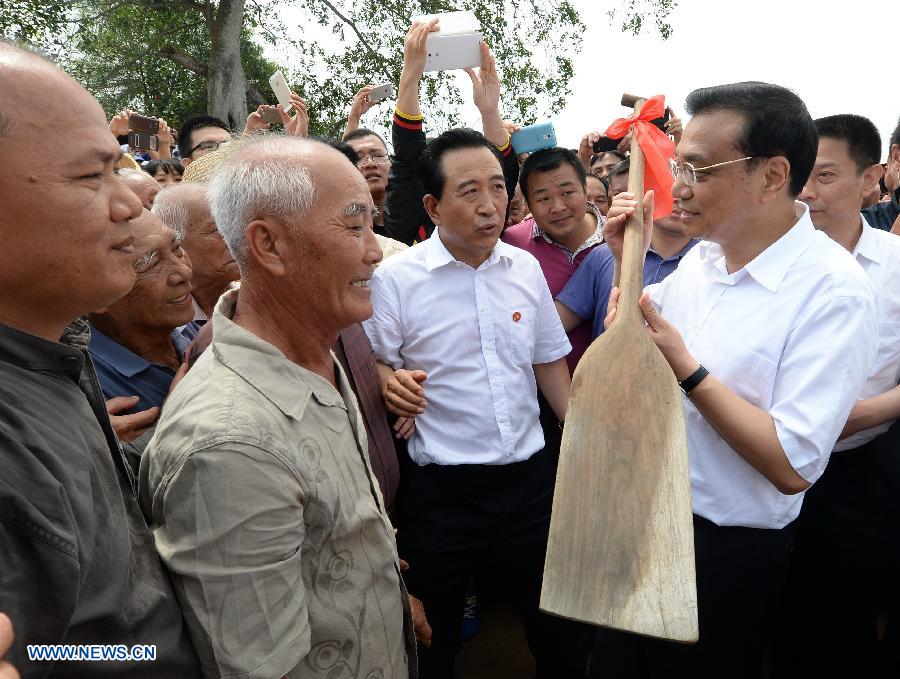
Chinese Premier Li Keqiang (R front), also a member of the Standing Committee of the Political Bureau of the Communist Party of China (CPC) Central Committee, pays a visit to Dongzhaigang Mangrove Forest Nature Reserve in Haikou, south China's Hainan Province, April 11, 2014. Li paid an inspection tour to south China's Hainan Province from April 10 to 11 after attending the Boao Forum for Asia (BFA) Annual Conference 2014. (Xinhua/Liu Jiansheng)

Chinese Premier Li Keqiang (R front), also a member of the Standing Committee of the Political Bureau of the Communist Party of China (CPC) Central Committee, talks with dock workers of Haikou Port in Haikou, south China's Hainan Province, April 11, 2014. Li paid an inspection tour to south China's Hainan Province from April 10 to 11 after attending the Boao Forum for Asia (BFA) Annual Conference 2014. (Xinhua/Liu Jiansheng)
Vice Chairman Du Yili Meets New Zealand Friends

On February 25, CNTA Vice Chairman Du Yili met the New Zealand delegation led by Maori Affairs Minister Pita Sharples.
Vice Chairman Du said that New Zealand was one of the first destinations of Chinese tourist groups and the two countries were witnessing more and more exchanges in tourism and culture sectors. Prime Minister John Key of New Zealand has paid two visits to CNTA and showed great interest in deepening bilateral tourism cooperation. Mr. Du said in addition to its spectacular natural landscape, the distinctive Maori culture added fuel to the appeal of New Zealand to Chinese tourist, built up their experiences and made the country one of the favorite overseas destinations of Chinese.
Mr. Du pointed out that in the next stage, competent authorities of the two countries should extend the cooperation scope to bring more fights, simplify visa formalities, enhance market research, support cultural exchanges between the youth, facilitate industrial cooperation and accelerate training of tour guides.
Mr. Pita Sharples applauded the suggestions on enhanced cooperation. He said that Maori culture and Chinese culture shared similarities and he personally had paid three visits to China and was affectionate to this land. He wished the two countries could intensify cooperation in culture, economics and trade and tourism sectors and make more efforts to build up the tie in between.
Representatives of New Zealand embassy in China, Maori Affairs Ministry, Maori Culture and Tourism Promotion Bureau, and CNTA Department of Tourism Promotion and International Liaison attended the meeting.
Xi Jinping and Denmark’s Queen Margrethe II Witness the Signing of MOU of China-Denmark Tourism Cooperation

On the afternoon of April 24, 2014, in the presence of Chinese President Xi Jinping and Denmark’s Queen Margrethe II, Wang Zhifa, Vice Chairman of China National Tourism Administration and Pei Desheng, Danish Ambassador to China, signed the Memorandum of Understanding (MOU) on Tourism Cooperation between China National Tourism Administration of the People’s Republic of China and the Ministry of Economic and Business Affairs of the Kingdom of Denmark.
Currently, China-Demark relations are at an all-time high, with the substantial cooperation between both sides reaping rich fruits. China has become Denmark’s largest trade partner in Asia and the second largest investment destination overseas. The signing of the MOU on tourism cooperation between China and Demark will create favorable conditions for the two countries to conduct substantial mutually beneficial tourism cooperation on the long-term basis. The deepening of China-Denmark cooperation in the tourism sector is bound to further the existing good relations between the two countries, boost mutual understanding and friendship between the two peoples, and play a positive role in promoting win-win cooperation for even greater achievements.
Luo Baoming Meets with Shao Qiwei

On April 23, 2014, Luo Baoming, Secretary of the CPC Hainan Provincial Committee, met in Sanya with Shao Qiwei, Chairman of China National Tourism Administration (CNTA), who came for the 2014 World Tourism and Travel Conference.
Luo Baoming indicated Hainan makes notable progress every year and currently it is intensifying efforts to build itself into an international tourism island. At present the priority is to reform and improve the comprehensive management service by international standards, and especially to enhance training of various talents. Today, Hainan must attach equal importance to development and management. Hainan will redouble its efforts to boost its tourism appeal and tourist product quality and make the management more standardized, so as to do a good job in developing tourism, the strategic pillar industry for the province.
Shao Qiwei said, under the leadership of the CPC Hainan Provincial Committee and Hainan Provincial Government, Hainan has made headway in economic and social development, and it leads the country in tourism facility construction. The tourism development reflects a region’s comprehensive development level. Overall, the level of Hainan tourism industry is on the rise. In recent years, new forms of tourism represented by the cruise and the yacht keep emerging and in these regards Hainan boasts huge development potential. It is hoped that Hainan will make bold explorations in system construction regarding cruise travel and improving supportive services. CNTA will, as always, support the construction of Hainan as an international tourism island and the growth of its tourism industry.
Shao Qiwei Meets with WTTC Chairman and President

On April 23, 2014, Shao Qiwei, Chairman of National Tourism Administration of China (NTAC), met in Sanya with Micheal Frenzel and David Scowsill, respectively Chairman and President of the World Travel & Tourism Council (WTTC) who came for 2014 World Tourism and Travel Conference.
Shao Qiewei said, in recent years, the Chinese tourism community and the WTTC have established sound partnerships. Succeeding to the 10th World Tourism and Travel Conference successfully held in Beijing in May 2010, the conference again lands in China, which fully reflects the WTTC puts a premium on the Chinese market and renders ready support for the Chinese tourism industry. At present Chinese tourism is in rapid development, as evidenced by the fast growth in the Chinese outbound and domestic travel. With the implementation of the tourism law and relevant polices on paid leave, the Chinese tourism market is expected to see further growth. The Chinese government won’t change the policy on Chinese citizen traveling abroad, and is ready to continue to push ahead the tourism cooperation with other countries in the word.
Frenzel thought highly of China’s economy and the development of Chinese tourism. He noted that the Chinese tourism industry and in particular Chinese travel market is undergoing fast development, which has aroused extensive attention in the world. The influence of Chinese tourism development on the world tourism is worth our deliberation and research. The WTTC is willing to reinforce its cooperation with the Chinese government tourism departments at various levels and tourism enterprises, so as to promote the tourism development across the world.
100 Doraemon Secret Gadgets Expo: For Fans Only

A young girl examines Doraemon statues up close. The 100 Doraemon Secret Gadgets Expo is being held at Beijng's Chaoyang Joy City shopping mall. Photo taken April 19, 2014. [Photo: CRIENGLISH.com/William Wang]

A young girl poses with Doraemon at the entrance to the expo. The 100 Doraemon Secret Gadgets Expo is being held at Beijng's Chaoyang Joy City shopping mall. Photo taken April 19, 2014. [Photo: CRIENGLISH.com/William Wang]
Doraemon, the robotic cat, has amassed a legion of devotees since his inception in the late 1960s. The Japanese character has a special "fourth dimensional pocket" from which magical gadgets and tools from the future can be produced. The expo at the Chaoyang Joy City shopping mall, had 100 Doraemons each showcasing one surprise or another.
The queue to buy tickets was a long one, considering that the expo itself was just a collection of virtually identical Doraemon effigies. This one contains a tube of toothpaste; that one has a pair of yellow gloves.
"I used to watch lots of Doraemon when I was a kid," admitted Tao Nuan, who was accompanying his wife to the exhibit, whilst holding a large Doraemon stuffed doll in his arms. "I'd like to take more pictures of the Doraemons, but there's too many people."
Six-year-old Kong Lingao, was really enjoying the expo: "It's my first time seeing Doraemon outside!" he exclaimed. "And I got some presents."
The expo is a short one. It opened on Saturday, and wraps up on Tuesday. In addition to the Doraemon expo, which requires a ticket, a number of Doraemon exhibits are on display on the many floors of Joy City. The uninitiated may be curious as to why so many people find the displays photo-worthy: the pink door is only a pink door to those unfamiliar with the "anywhere door" that can take you to any place or time you desire.
Many people would be happy to step through the anywhere door to arrive at the front of the line to buy Doraemon merchandise.
Expo entrance fee: 50 yuan.
Flying over the Sichuan-Tibet Plateau
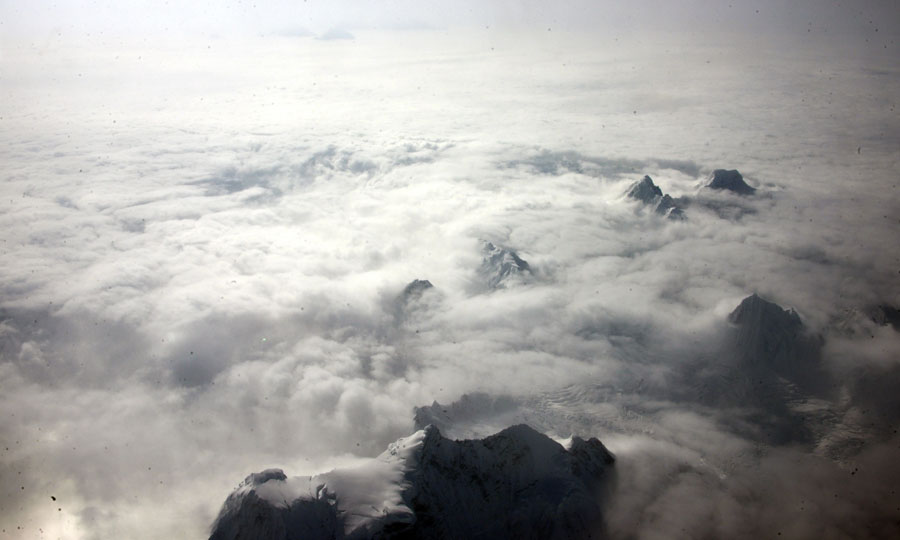
Looking down at the mountain range, I felt a rush and hurriedly took out my camera. I pressed the shutter and took several photos through the window when I was flying over the Sichuan-Tibet plateau. [Photo: CRIENGLISH.com / Xia Jixuan]
As my Tibet Airlines flight to Nyingchi was taking off in Chengdu, a thick array of clouds surrounded my plane and I couldn't see a thing out of the window. By the time the plane had risen to cruising altitude, the sky had cleared up.
I could see a thick layer of clouds below, covering the land like a wool carpet. About an hour later, with the changing sunlight, I could see that the landforms had started to change, from fluctuating mountains to humps and deep valleys, from snowcapped mountains to peaks surrounded by clouds.
The plane slowed down and I could see the mountain peaks soaring into the sky clearly. When the plane took a turn, the wing almost scratched a mountain top.
Looking down at the mountain range, I felt a rush and hurriedly took out my camera. I pressed the shutter and took several photos through the window when I was flying over the Sichuan-Tibet plateau.

Looking down at the mountain range, I felt a rush and hurriedly took out my camera. I pressed the shutter and took several photos through the window when I was flying over the Sichuan-Tibet plateau. [Photo: CRIENGLISH.com / Xia Jixuan]
Colourful Original Folk Culture Festival in China's Guizhou

Actresses of the Miao ethnic group perform "Herb Picking" at the opening of the Original Folk Culture Festival held in Qingzhen City of southwest China's Guizhou Province. Series of activities like folk culture tours, ethnic-styled competitions, folk custom photo shows, drug bathing, etc. will be held during the festival.

A tourist is attracted by a special ethnic costume at the Original Folk Culture Festival held in Qingzhen City of southwest China's Guizhou Province. Series of activities like folk culture tours, ethnic-styled competitions, folk custom photo shows, drug bathing, etc. will be held during the festival. [Xinhua/Jin Yulong]
Spring Festival tourism boost in China
BEIJING, Feb. 1 (Xinhuanet) -- Thanks to improved living standards, many Chinese can now afford to travel during the Spring Festival holiday season. So where are they headed? CCTV reporter Ji Yi gives the peak at this year's tourism hotspots.
If you fancy travelling during the Spring Festival season you would be best advised to book at least a month in advance.
More and more tourists are choosing the holiday period to take a trip within China. But trips abroad are also proving popular.
Wu Qian, Manager of China Swan International Tours, said, “Although the exchange rate means it has become favorable for Chinese tourists to travel abroad, this year's price has risen a lot, due to the increase in air fares. But this hasn't affected tourist demand too much.”
Tropical islands are, as always, the most popular destinations during winter. A tour manager told us that although the price of a tour package to Thailand's Phuket Island has gone up by a third compared to last year, places are still hard to come by and are fully booked 20 days in advance.
This year, Hainan Island in south China is still proving a hot destination, especially after the movie The One II, was filmed there. It has attracted many people there to experience the movie scene.
Gu Chuan, Deputy GM, said, “The thing tourists care most about, is service. As many people are traveling for relaxation, as much as visiting places of interests, they focus more on the ccommodation.”
As for people still planning to travel right after the Spring Festival holiday, the advice is to make a booking, as early as possible.
If you fancy travelling during the Spring Festival season you would be best advised to book at least a month in advance.
More and more tourists are choosing the holiday period to take a trip within China. But trips abroad are also proving popular.
Wu Qian, Manager of China Swan International Tours, said, “Although the exchange rate means it has become favorable for Chinese tourists to travel abroad, this year's price has risen a lot, due to the increase in air fares. But this hasn't affected tourist demand too much.”
Tropical islands are, as always, the most popular destinations during winter. A tour manager told us that although the price of a tour package to Thailand's Phuket Island has gone up by a third compared to last year, places are still hard to come by and are fully booked 20 days in advance.
This year, Hainan Island in south China is still proving a hot destination, especially after the movie The One II, was filmed there. It has attracted many people there to experience the movie scene.
Gu Chuan, Deputy GM, said, “The thing tourists care most about, is service. As many people are traveling for relaxation, as much as visiting places of interests, they focus more on the ccommodation.”
As for people still planning to travel right after the Spring Festival holiday, the advice is to make a booking, as early as possible.
Fantastic scenery of Jiuzhaigou fascinates visitors

Tourists view scenery in the Jiuzhaigou scenic area, southwest China's Sichuan Province, Jan. 9, 2010. Beautiful winter scenery of Jiuzhaigou attracts many visitors each year. (Xinhua/Liu Jin)
Visitors Flock to a Snowy Jiuzhai Valley

Heavy snow on Wednesday night, November 18, 2009, blankets Jiuzhai Valley (Jiuzhaigou) in southwestern China's Sichuan province, turning the landscape from a flamboyant Autumn scene into a fairy tale winterland. It is said to be the biggest snow so far this winter in Jiuzhai valley, and has lowered the entrance fee from 220 yuan peak price to 80 yuan to cope with the slack period in ticket sales.
China predicted to be largest tourist market for U.S. in 2018
NEW YORK, Oct. 8 (Xinhua) -- China is predicted to be the top tourist source market for the United States in 2018 with the number of visiting Chinese hitting 4.7 million, the country's official tourism and marketing organization Brand USA said on Tuesday.
Chris Thomson, President and CEO of Brand USA, told reporters on the sideline of a Sino-U.S. tourism exchange event, that the number of Chinese travelers visiting the United States is increasing by 35 percent each year, beating any other country in the world.
Chinese travelers spent 8.8 billion U.S. dollars last year in America, and each spent an average of 7,000 U.S. dollars, making America the top spending destination for Chinese tourists, he said.
Cooperation between the United States and China in tourism has been outstanding, according to Shao Qiwei, chief of China National Tourism Administration, and the level of exchange between the two countries keeps expanding.
He said 5.76 million people have travelled to the United States since the country granted the Authorized Travel Destination Status to Chinese citizens in 2007.
According to Shao, China and the United States, on the basis of negotiation, will explore possibilities to strengthen tourism promotion, accelerate integration of the tourism industry, and employ modern technology to further promote tourism.
Chris Thomson, President and CEO of Brand USA, told reporters on the sideline of a Sino-U.S. tourism exchange event, that the number of Chinese travelers visiting the United States is increasing by 35 percent each year, beating any other country in the world.
Chinese travelers spent 8.8 billion U.S. dollars last year in America, and each spent an average of 7,000 U.S. dollars, making America the top spending destination for Chinese tourists, he said.
Cooperation between the United States and China in tourism has been outstanding, according to Shao Qiwei, chief of China National Tourism Administration, and the level of exchange between the two countries keeps expanding.
He said 5.76 million people have travelled to the United States since the country granted the Authorized Travel Destination Status to Chinese citizens in 2007.
According to Shao, China and the United States, on the basis of negotiation, will explore possibilities to strengthen tourism promotion, accelerate integration of the tourism industry, and employ modern technology to further promote tourism.
Peak season for fall foliage in Beijing

Leaves started turning color in October in the city of Beijing, turning red leaf-covered places into popular tourist destinations.
Tourists enjoy the fall foliage at the Xiangshan Park in Beijing, Oct 21, 2013. (Source: xinhuanet.com)
Consecration ceremony held in Nengren Zen Temple

Photo taken on Oct. 18, 2013 shows a Chinese character of Buddha on a wall of the Nengren Zen Temple in Jiujiang, east China's Jiangxi Province. Established some 1,500 years ago, the temple features intact Buddhism palaces, zen houses and other relics, which make it the largest ancient architectural complex in the city. (Xinhua/Xue Dongmei)
Walking event held for Beijing int''''l community

BEIJING, Oct. 29 (Xinhuanet) -- Tourists at the Summer Palace, a major tourist destination in Beijing, must have been surprised to see such a large and international group of people marching though the palace gate last Saturday.
Around 1,000 people of all ages, including international students, professionals, and members of the diplomatic community from almost 100 different countries strolled through the palace on Oct. 26, for the 2013 "Walk Around Kunming Lake For International Friends," a thirteen-year old Beijing tradition.
They toted specially designed white bags and "walker" stickers, covering an eight-kilometer course, encircling the beautifully-landscaped Kunming Lake, which was originally built during the Yuan Dynasty in 1291, and was incorporated into the palace gardens from 1750 to 1764 during the Qing Dynasty.
The event aimed to help foreigners working in China enjoy nature and the harmony between mankind and the environment, and integrate into the local community, according to the event organizers, which included the Beijing People's Association for Friendship with Foreign Countries, the Beijing NGO Association for International Exchanges, the Foreign Affairs Office of Beijing Municipal People's Government, the Information Office of Beijing Municipal People's Government and the Beijing Municipal Bureau of Foreign Experts Affairs.
An international student from India, who attended the walk, said that he relished the chance to be outdoors, "it's great to be outside in this beautiful setting, and people here are enjoying some leisure time."
The event's theme, "A Healthy Long Walk and Beautiful Beijing," promoted an easy and interesting way of keeping fit and advocated a day when people can relax with a leisurely walk and enjoy the beauty of the landscape at a slow pace.
Red-billed gulls spend winter in Kunming
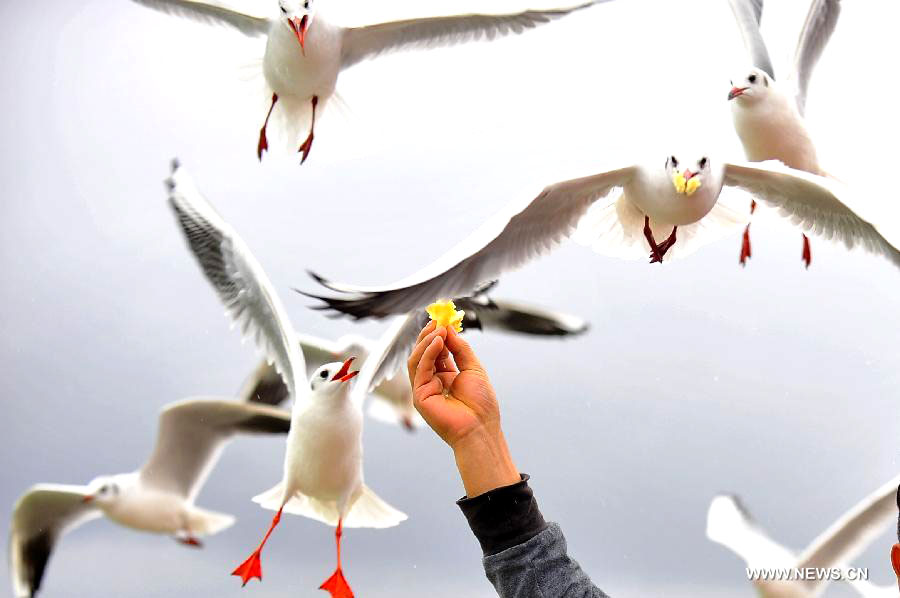
A tourist feeds red-billed gulls on Caohai Levee of the Dianchi Lake in Kunming, capital of Southwest China's Yunnan province, Oct 28, 2013. Tens of thousands of red-billed gulls chose to spend winter in Kunming in recent years thanks to comfortable ecological environment in the city. [Photo/Xinhua]
Snow scenery in NE China''s Jilin

Photo taken on Nov. 17, 2013 shows the snow scenery in Ji'an City, northeast China's Jilin Province. Many parts of Jilin witnessed this winter's first snow from Saturday to Sunday. (Xinhua/Jin Yi)
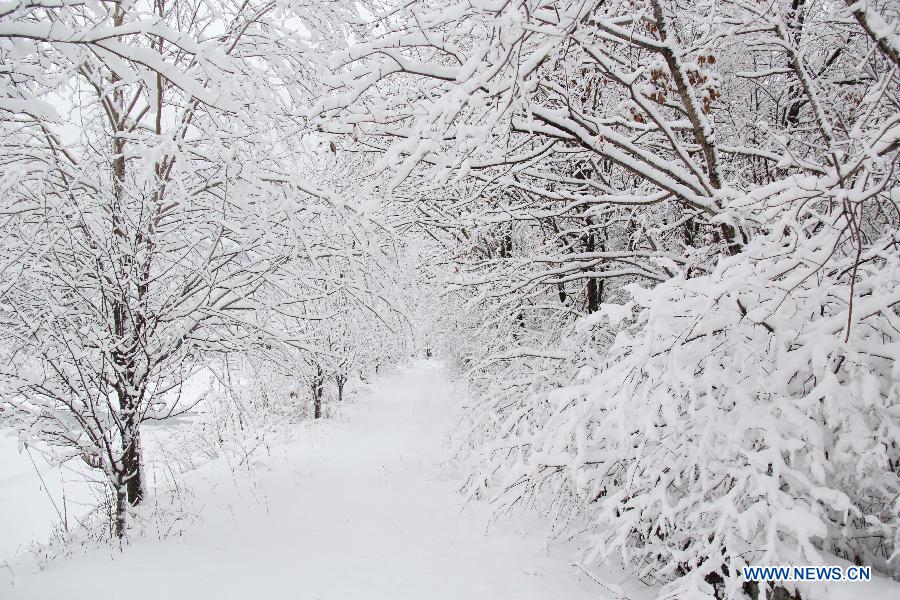
Shanghai: Airport’s visa checks are fastest in world
BEIJING, Nov. 16 (Xinhuanet) -- Shanghai’s Pudong International Airport has the speediest visa checks of any major airport in the world, according to an industry body survey.
Airports Council International, a trade representative of the world’s airports, tested more than 100 major airports around the globe in the third quarter and ranked Pudong first in terms of “waiting time for visa check.”
Terminal 2 of the Pudong International Airport can open up to 47 channels and deal with 70 to 90 passengers in a minute.
Almost 70,000 passengers use the airport daily, with a record high of 95,000.
This is the first time for a domestic airport to top the ranking, Xinmin Evening News reported.
Beijing Capital International Airport had ranked second previously but this time dropped to third, its place taken by Seoul Incheon International Airport.
China has two more airports on the top 10 list. The Longjia International Airport in Changchun, capital of northeastern China’s Jilin Province, ranked fifth, followed by the Meilan International Airport in Haikou, capital of the southern island province Hainan.
The Pudong International Airport has been China’s mainland’s busiest airport for 10 years.
It has an advanced electronic system to monitor passenger flow, while batches of officers receive training every week.
Every quarter, ACI asks an institution to determine and review airports around the world, in a survey based on 36 standards, such as facilities and service.
Airports Council International, a trade representative of the world’s airports, tested more than 100 major airports around the globe in the third quarter and ranked Pudong first in terms of “waiting time for visa check.”
Terminal 2 of the Pudong International Airport can open up to 47 channels and deal with 70 to 90 passengers in a minute.
Almost 70,000 passengers use the airport daily, with a record high of 95,000.
This is the first time for a domestic airport to top the ranking, Xinmin Evening News reported.
Beijing Capital International Airport had ranked second previously but this time dropped to third, its place taken by Seoul Incheon International Airport.
China has two more airports on the top 10 list. The Longjia International Airport in Changchun, capital of northeastern China’s Jilin Province, ranked fifth, followed by the Meilan International Airport in Haikou, capital of the southern island province Hainan.
The Pudong International Airport has been China’s mainland’s busiest airport for 10 years.
It has an advanced electronic system to monitor passenger flow, while batches of officers receive training every week.
Every quarter, ACI asks an institution to determine and review airports around the world, in a survey based on 36 standards, such as facilities and service.
China's Buddhist mountain to have airport
TAIYUAN, Nov. 8 (Xinhua) -- Mount Wutai, one of four Buddhist mountains in north China's Shanxi Province, should be served by aviation before the end of 2015, the local government said on Friday.
Under construction, Mount Wutai Airport is 71 km away from the core scenic site. With a budget of 900 million yuan (about 150 million U.S. dollars), the airport will include a 13,000-square-meter terminal building with five aircraft stances and handle 35,000 passengers per year.
Most of the construction work should have been done by October next year, and normal operation should begin by the end of 2015, with direct flights to major cities including Shanghai, Guangzhou, Chengdu and Kunming.
Added to UNESCO's World Heritage List in 2009, Mount Wutai is home to about 50 Buddhist temples built between the 1st century and the early 20th century.
Under construction, Mount Wutai Airport is 71 km away from the core scenic site. With a budget of 900 million yuan (about 150 million U.S. dollars), the airport will include a 13,000-square-meter terminal building with five aircraft stances and handle 35,000 passengers per year.
Most of the construction work should have been done by October next year, and normal operation should begin by the end of 2015, with direct flights to major cities including Shanghai, Guangzhou, Chengdu and Kunming.
Added to UNESCO's World Heritage List in 2009, Mount Wutai is home to about 50 Buddhist temples built between the 1st century and the early 20th century.
Xintiandi: A Hot Street for Walking in Shanghai

Shanghai's Xintiandi is one of the city's most famous areas and is extremely popular with tourists. Xintiandi was initially built with the unique Shikumen architectural style characteristic of old Shanghai, but has now transformed into an international walking street famous for its commercial, entertainment and leisure, and cultural offerings. Key to its essence is its combination of Chinese and western, old and new culture, and its integration of traditional Shikumen and new buildings. Xintiandi is now widely recognized as a cultural symbol of Shanghai. [Photo: CRIENGLISH.com]

Beijing plans to ratchet up promotion of visa-free stays
BEIJING, Nov. 4 (Xinhuanet) -- Beijing will produce more incentives and work harder to promote its 72-hour visa waiver to attract more transit passengers.
Authorities in the Chinese capital said they are considering offering discounts at hotels and shopping areas for tourists, as well as working more with airlines to publicize the policy more.
Beijing Capital International Airport's planning and development department said visitors might get exclusive discounts on dining and free accommodation if they spend a certain amount at the airport.
The Beijing General Station of Exit and Entry Frontier Inspection also said it will cooperate more with airlines, flight associations home and abroad, and tourism bureaus to make sure more travelers are informed of the visa exemption.
The station promised to simplify the transit application process.
Ji Lixia, the general station's assistant director, said the process has become easier than it was earlier this year, when applying for the visa exemption took a lot of time and effort, and that it now takes tourists only two minutes after they land.
"Our staff members are fluent in English and 18 other languages to ensure the language barrier does not stand in the way of transit tourists," she said.
"The number of daily applicants has soared to 60. That's impressive compared with the handful of tourists in January."
A Russian visitor who arrived in Beijing on Friday said it was the first time he had tried the 72-hour visa waiver, and found it convenient.
"I found information about the visa exemption on the Internet," said Sergey, who declined to give his last name. "I will go on a business trip to Japan and it's very convenient to check out China before that, and it's without a visa."
He said he had not made up his mind where in Beijing he will go, but thought 72 hours is a reasonable duration.
Introduced on Jan 1, the Beijing visa exemption allows tourists from 45 countries to stay in the capital for three days without a visa.
The program had attracted 10,191 transit passengers as of Oct 19, with 5,270 visits during the first half of the year.
The countries whose citizens are eligible for the exemption were decided in accordance with the backgrounds of visitors Beijing and Shanghai had received during the past few years, according to the Beijing government.
Most applicants for the visa-free stay are from Russia, the United States and Germany, and most took flights from Air China, Hainan Airlines, Hong Kong Airlines and Russia's S7 Airlines, the station said.
June had the most monthly transit visits — 1,165.
Ji said nearly all transit passenger applications are approved. Occasionally, several applicants are denied because they are not from the 45 specified countries and regions.
Yang Jinsong, a researcher at the China Tourism Academy, said the government should look at the spending habits of tourists from the 45 countries and come up with specialized tour packages tailored to their preferences.
"Some of the tour packages made years ago are not attractive to foreigners today," he said.
"For example, considering some of them are on business trips, the government can come up with three-day tours around the city that show its business potential as well as new attractions for these tourists."
The station and airport also warn visitors planning to come to Beijing without a visa to fully understand the details of visa waiver policy to avoid unnecessary troubles.
"The policy applies only to foreign visitors with a ticket heading for a third country, rather than a third city. For example, someone from Los Angeles cannot stay in Beijing without a visa if he is destined to go to San Francisco afterward," Ji said.
Visa-free tourists cannot go outside the capital during the three-day visit or extend their stay. Those who must can apply for permission to the city's Public Security Bureau, she said.
Authorities in the Chinese capital said they are considering offering discounts at hotels and shopping areas for tourists, as well as working more with airlines to publicize the policy more.
Beijing Capital International Airport's planning and development department said visitors might get exclusive discounts on dining and free accommodation if they spend a certain amount at the airport.
The Beijing General Station of Exit and Entry Frontier Inspection also said it will cooperate more with airlines, flight associations home and abroad, and tourism bureaus to make sure more travelers are informed of the visa exemption.
The station promised to simplify the transit application process.
Ji Lixia, the general station's assistant director, said the process has become easier than it was earlier this year, when applying for the visa exemption took a lot of time and effort, and that it now takes tourists only two minutes after they land.
"Our staff members are fluent in English and 18 other languages to ensure the language barrier does not stand in the way of transit tourists," she said.
"The number of daily applicants has soared to 60. That's impressive compared with the handful of tourists in January."
A Russian visitor who arrived in Beijing on Friday said it was the first time he had tried the 72-hour visa waiver, and found it convenient.
"I found information about the visa exemption on the Internet," said Sergey, who declined to give his last name. "I will go on a business trip to Japan and it's very convenient to check out China before that, and it's without a visa."
He said he had not made up his mind where in Beijing he will go, but thought 72 hours is a reasonable duration.
Introduced on Jan 1, the Beijing visa exemption allows tourists from 45 countries to stay in the capital for three days without a visa.
The program had attracted 10,191 transit passengers as of Oct 19, with 5,270 visits during the first half of the year.
The countries whose citizens are eligible for the exemption were decided in accordance with the backgrounds of visitors Beijing and Shanghai had received during the past few years, according to the Beijing government.
Most applicants for the visa-free stay are from Russia, the United States and Germany, and most took flights from Air China, Hainan Airlines, Hong Kong Airlines and Russia's S7 Airlines, the station said.
June had the most monthly transit visits — 1,165.
Ji said nearly all transit passenger applications are approved. Occasionally, several applicants are denied because they are not from the 45 specified countries and regions.
Yang Jinsong, a researcher at the China Tourism Academy, said the government should look at the spending habits of tourists from the 45 countries and come up with specialized tour packages tailored to their preferences.
"Some of the tour packages made years ago are not attractive to foreigners today," he said.
"For example, considering some of them are on business trips, the government can come up with three-day tours around the city that show its business potential as well as new attractions for these tourists."
The station and airport also warn visitors planning to come to Beijing without a visa to fully understand the details of visa waiver policy to avoid unnecessary troubles.
"The policy applies only to foreign visitors with a ticket heading for a third country, rather than a third city. For example, someone from Los Angeles cannot stay in Beijing without a visa if he is destined to go to San Francisco afterward," Ji said.
Visa-free tourists cannot go outside the capital during the three-day visit or extend their stay. Those who must can apply for permission to the city's Public Security Bureau, she said.
First snowfall brings seasonal charm to Harbin
This winter's first snow has turned Harbin, capital city of Northeast China's Heilongjiang province, into a world of white. Tourists and citizens flock to the city's most famous scenic spots to enjoy the pleasure of a snow white world.
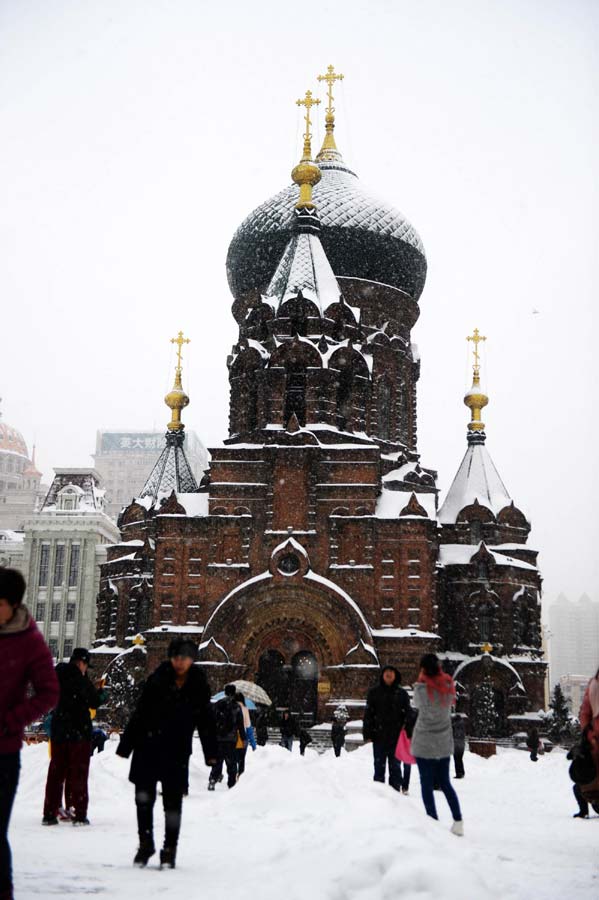
St. Sophia Church in Harbin is a popular destination for many people.[Photo/Xinhua]

A snapshot of Harbin's Central street. [Photo/Xinhua]

St. Sophia Church in Harbin is a popular destination for many people.[Photo/Xinhua]

A snapshot of Harbin's Central street. [Photo/Xinhua]
China's Dalian to start 72-hour visa-free stays
DALIAN, Nov. 24 (Xinhua) -- The coastal city of Dalian in northeast China will start 72-hour visa-free stay service for travelers from 45 countries on Jan. 1, 2014, local tourism authorities said.
Dalian is the sixth city on the Chinese mainland to introduce the policy.
Travelers from countries such as the United States, Britain, Russia, France, Germany and Canada may enjoy the policy if they hold third country visas and have booked plane tickets to leave for a third country or region within 72 hours.
The scheme will boost local tourism development and exchanges with the world, said a local tourism official on Saturday.
In 2012, Dalian hosted 49 million tourist arrivals, including 1.28 million from overseas, with total tourism revenues of 76.7 billion yuan (12.5 billion U.S. dollars).
So far, Beijing, Shanghai, Guangzhou and Chengdu have already launched the 72-hour visa-free service. Chongqing Municipality is expected to launch the same service this month.
Dalian is the sixth city on the Chinese mainland to introduce the policy.
Travelers from countries such as the United States, Britain, Russia, France, Germany and Canada may enjoy the policy if they hold third country visas and have booked plane tickets to leave for a third country or region within 72 hours.
The scheme will boost local tourism development and exchanges with the world, said a local tourism official on Saturday.
In 2012, Dalian hosted 49 million tourist arrivals, including 1.28 million from overseas, with total tourism revenues of 76.7 billion yuan (12.5 billion U.S. dollars).
So far, Beijing, Shanghai, Guangzhou and Chengdu have already launched the 72-hour visa-free service. Chongqing Municipality is expected to launch the same service this month.
Yellow Dragon Cave in Zhangjiajie

Yellow Dragon Cave's name comes from a legend of a dragon that lived inside the cave, but it also seems to make reference to its monstrous size: the cave in Hunan province, southern China, reportedly covers over 100,000 square meters. Visitors often spend over two hours taking in its cavernous caverns, marveling at stalagmites and stalactites that are millions of years in the making. A word of advice: visit the bathroom before entering.
Tours take in groups of 60 people, forsaking the sun's rays to enter a world backlit by colored LEDs. But the tour groups often disintegrate as they progress along the lengths of the cave. A tunnel leads people deeper and deeper into the depths of the cave, and tour guides with microphones note various stalagmites which occasionally resemble the objects they are named after.
The plip plop sound of dripping water is omnipresent, each drop slowly shaping the rock formations. Visitors hold their fingers and tongues up to stalagmites to catch the constant trickle of water.
But the water at Yellow Dragon Cave can be more than a trickle. At one point, a 40 meter waterfall strangely drops out of the centre of a hall ceiling, its origin almost impossible to discern. Rivers flow through different depths of the cave, and at one point, all visitors hop into boats to cautiously cruise 800 meters of the maze-like cave. Views are impressive as many of the caverns are incredibly large, at times tall enough to house a thirty-storey building. Even claustrophobics can enjoy this cave.
The stalagmites at Yellow Dragon are also impressively tall. The ten thousand year old Sea-Suppressing Needle is a highlight of the cave; it is a 19.2 meter tall toothpick of a stalagmite which has been insured for 100 million yuan. The cave's largest stalagmite is 12 meters tall and 50 meters in circumference. Its name is King's Throne, though every child would find Scary Monster's Head to be a more appropriate moniker.
These two particular stalagmites are held in the Dragon's Palace hall, a veritable forest of stalactites and stalagmites. It is the oldest and largest hall of the cave, densely packed with curious rock formations. An echo platform near the exit of the hall ensures that the sound of people's yelling and clapping keep the hall filled with reverberating sounds of joy, to the chagrin of some.
For those who prefer a more intimate experience, the Labyrinth is an additional section of cave available for viewing. It is a cave which is sandwiched between a river above and a river below. Accordingly, this moisture-filled cave is thickly populated with columns (stalactites and stalagmites that have made contact and grown into one stone). Visitors must suck in their bellies to squeeze through some tight spots.
The majestic spaciousness of the halls above is nonexistent in the Labyrinth, and visitors quickly become wary of knocking their heads against the bulbous hanging stalactites. Tour guides in the Labyrinth point out how some rock formations are hollow or porous to light, providing more in-depth geological information about the cave and its workings.
Yellow Dragon Cave is certainly one of the world's best caves. Even those who know nothing about caves can recognize that this one can't possibly have many equals. It was one of China's first tourist destinations which was given the national AAAA ranking. Accordingly, it is well set up to handle large numbers of people should they arrive.
Getting to Hunan Province's Yellow Dragon Cave (Huang Long Dong (黄龙洞)):
From Zhangjiajie bus station (next to the train station), take the long distance bus to Wulingyuan bus station. Then take bus #1 to Huang Long Dong (40 minutes).
Entrance fee: 80 yuan
Labyrinth (Migong):15 yuan
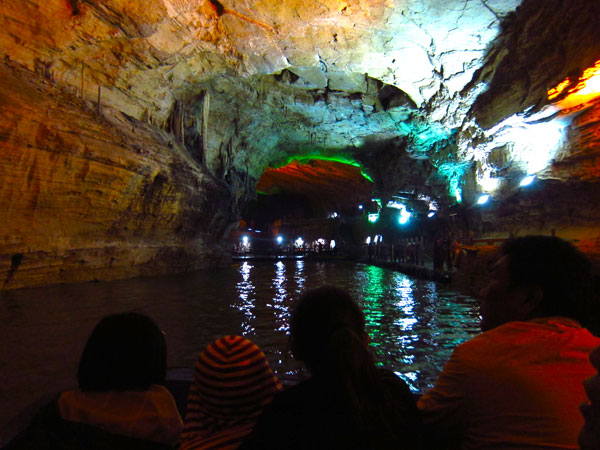
Visitors gaze at the surrounding caves while cruising along Yellow Dragon Cave's Rattle River. [Photo/CRIENGLISH.com]
Villages of persimmons

In early winter, harvested persimmons are strung together and hung up in front of almost every house. Photos by Ju Chuanjiang / China Daily
In the mountains of Shandong province, Ju Chuanjiang and Zhao Ruixue discover settlements rich in color and blessed by nature.
Autumn seems reluctant to leave the villages in the southern mountainous area of Qingzhou in Shandong province. Although it is already early into the coldest season of the year, these hamlets nestled into the hilly slopes are still wearing their fall colors of rich red, yellow and green, thanks to the smoke and phoenix trees and the pines that surround them.
But there is one color that stands out, dotting the landscape like jewels - orange.
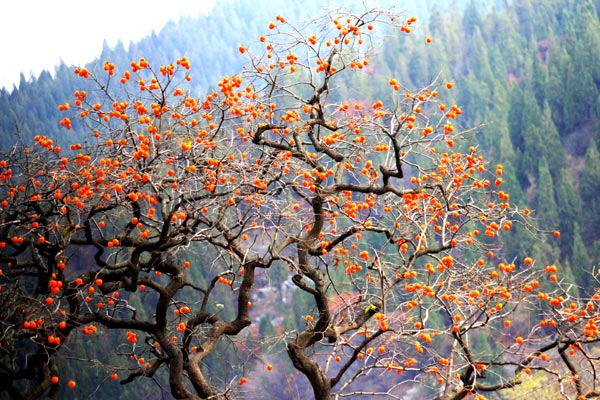
The leaves have all fallen, leaving just the red gold fruits attached to gnarled branches.
In this region, the villages are famous for their quiet, undisturbed lifestyles, and their persimmons. Even though the peak has long passed, we managed to catch the last brilliance of the autumn harvest.
Narrow tracks to the villages are the only approach and the roads become more and more precipitous the higher we climb. Our 30-year-old driver, with seven years of driving under his belt, is giving the roads his full concentration.
"I dare not look down," he says.
Half an hour later, we reach Shangshao village in Wangfen town, and the scenery changes from beautiful to breathtaking. There are rolling mountains in the distance and a sea of clouds hovering over the trees.
Here, century-old persimmon trees are as tall as 6 meters. The leaves have all fallen, leaving just the red gold fruits attached to gnarled branches.
Zhang Yunwu, a resident at the village, was busy harvesting the last persimmons.
"The 50 odd persimmon trees I planted can produce around 5,000 kilograms of persimmons each year," Zhang says proudly. "The dried persimmons are exported to other countries," he adds with a big smile.
According to Zhang, persimmon trees are planted everywhere in the hundreds of valleys in the southern area of Qingzhou, making it a famous persimmon production base in Shandong.
"We have been planting persimmon trees for generations. Persimmons produced here have been selected as gifts to the courts since the Tang Dynasty (AD 618-907)," Zhang says.
In early winter, harvested persimmons have already been strung together and hung up in front of almost every house, creating a spread of color.
It's not such an easy process as just stringing them up.
Farmers have to climb up the tall trees on creaky ladders to collect the fruit. Before stringing the persimmons up, they have to be carefully peeled.
To make quality persimmon cakes, as the dried fruits are called, Zhang says he has to massage them regularly.
"A week after you first string them up, you have to gently massage each persimmon every other day," Zhang says. A light touch massage works better than a deep, he says.
After a few weeks of rubbing, the fructose in the persimmons rises to the surface, making it appear as if each fruit has been dipped in powdered sugar. The fruits are done when they are properly dehydrated and have a chewy texture.
Qingzhou produces more than 30,000 tons of persimmons and the dried fruit is sold to dozens of countries, including Japan, the Republic of Korea and the United States.
Walking through the villages is to be transported through time and space. The houses are made of stone and mud, and residents still get their water from wells. Electrical appliances are rare.
A farmyard symphony of barks, crows and bleats reminds the visitors how far they have come from the city.
Located 900 meters above sea level, Dongding village has weathered more than 150 years in the mountains. But now, the harsh living conditions have decimated the population to just about 20.
In the company of a sheep and a dog, 79-year-old Yang Tingshui says he's very satisfied with life.
"My children invited me to live with them in the modern building, but I declined. I prefer to spend the rest of my life here," Yang says, adding that life in the village is simple and healthy.
Film directors come here often to take advantage of the picturesque scenery, ancient houses and traditional lifestyle. Among the movies filmed here are Journey to the West, with a plot set in the Tang Dynasty, and Outlaws of the Marsh, which is about stories of the Northern Song Dynasty (960-1127).
City adventurers who want to stay for a few days can rent a room from residents in Wenli village. It will cost 30 yuan ($4.9) a day, and that covers accommodation and meals. And you get to enjoy the harvests from the mountains, including persimmon cakes, walnuts, peanuts, hawthorn berries, as well as all kinds of wild vegetables.
Thursday, April 24, 2014
China's Dalian to start 72-hour visa-free stays
DALIAN, Nov. 24 (Xinhua) -- The coastal city of Dalian in northeast China will start 72-hour visa-free stay service for travelers from 45 countries on Jan. 1, 2014, local tourism authorities said.
Dalian is the sixth city on the Chinese mainland to introduce the policy.
Travelers from countries such as the United States, Britain, Russia, France, Germany and Canada may enjoy the policy if they hold third country visas and have booked plane tickets to leave for a third country or region within 72 hours.
The scheme will boost local tourism development and exchanges with the world, said a local tourism official on Saturday.
In 2012, Dalian hosted 49 million tourist arrivals, including 1.28 million from overseas, with total tourism revenues of 76.7 billion yuan (12.5 billion U.S. dollars).
So far, Beijing, Shanghai, Guangzhou and Chengdu have already launched the 72-hour visa-free service. Chongqing Municipality is expected to launch the same service this month.
Dalian is the sixth city on the Chinese mainland to introduce the policy.
Travelers from countries such as the United States, Britain, Russia, France, Germany and Canada may enjoy the policy if they hold third country visas and have booked plane tickets to leave for a third country or region within 72 hours.
The scheme will boost local tourism development and exchanges with the world, said a local tourism official on Saturday.
In 2012, Dalian hosted 49 million tourist arrivals, including 1.28 million from overseas, with total tourism revenues of 76.7 billion yuan (12.5 billion U.S. dollars).
So far, Beijing, Shanghai, Guangzhou and Chengdu have already launched the 72-hour visa-free service. Chongqing Municipality is expected to launch the same service this month.
Yellow Dragon Cave in Zhangjiajie
Yellow Dragon Cave in Zhangjiajie
2013-11-22 16:49:58 CRIENGLISH.com Font Size:[LMS] Select blackround-color:




Yellow Dragon Cave's name comes from a legend of a dragon that lived inside the cave, but it also seems to make reference to its monstrous size: the cave in Hunan province, southern China, reportedly covers over 100,000 square meters. Visitors often spend over two hours taking in its cavernous caverns, marveling at stalagmites and stalactites that are millions of years in the making. A word of advice: visit the bathroom before entering.
Tours take in groups of 60 people, forsaking the sun's rays to enter a world backlit by colored LEDs. But the tour groups often disintegrate as they progress along the lengths of the cave. A tunnel leads people deeper and deeper into the depths of the cave, and tour guides with microphones note various stalagmites which occasionally resemble the objects they are named after.
The plip plop sound of dripping water is omnipresent, each drop slowly shaping the rock formations. Visitors hold their fingers and tongues up to stalagmites to catch the constant trickle of water.
But the water at Yellow Dragon Cave can be more than a trickle. At one point, a 40 meter waterfall strangely drops out of the centre of a hall ceiling, its origin almost impossible to discern. Rivers flow through different depths of the cave, and at one point, all visitors hop into boats to cautiously cruise 800 meters of the maze-like cave. Views are impressive as many of the caverns are incredibly large, at times tall enough to house a thirty-storey building. Even claustrophobics can enjoy this cave.
The stalagmites at Yellow Dragon are also impressively tall. The ten thousand year old Sea-Suppressing Needle is a highlight of the cave; it is a 19.2 meter tall toothpick of a stalagmite which has been insured for 100 million yuan. The cave's largest stalagmite is 12 meters tall and 50 meters in circumference. Its name is King's Throne, though every child would find Scary Monster's Head to be a more appropriate moniker.
These two particular stalagmites are held in the Dragon's Palace hall, a veritable forest of stalactites and stalagmites. It is the oldest and largest hall of the cave, densely packed with curious rock formations. An echo platform near the exit of the hall ensures that the sound of people's yelling and clapping keep the hall filled with reverberating sounds of joy, to the chagrin of some.
For those who prefer a more intimate experience, the Labyrinth is an additional section of cave available for viewing. It is a cave which is sandwiched between a river above and a river below. Accordingly, this moisture-filled cave is thickly populated with columns (stalactites and stalagmites that have made contact and grown into one stone). Visitors must suck in their bellies to squeeze through some tight spots.
The majestic spaciousness of the halls above is nonexistent in the Labyrinth, and visitors quickly become wary of knocking their heads against the bulbous hanging stalactites. Tour guides in the Labyrinth point out how some rock formations are hollow or porous to light, providing more in-depth geological information about the cave and its workings.
Yellow Dragon Cave is certainly one of the world's best caves. Even those who know nothing about caves can recognize that this one can't possibly have many equals. It was one of China's first tourist destinations which was given the national AAAA ranking. Accordingly, it is well set up to handle large numbers of people should they arrive.
Getting to Hunan Province's Yellow Dragon Cave (Huang Long Dong (黄龙洞)):
From Zhangjiajie bus station (next to the train station), take the long distance bus to Wulingyuan bus station. Then take bus #1 to Huang Long Dong (40 minutes).
Entrance fee: 80 yuan
Labyrinth (Migong):15 yuan

Visitors gaze at the surrounding caves while cruising along Yellow Dragon Cave's Rattle River. [Photo/CRIENGLISH.com]
China Southern explores direct China route to New Zealand''s South Island
WELLINGTON, Nov. 27 (Xinhua) -- New Zealand's South Island will take its first step in opening directly to Chinese visitors next year when China Southern Airlines flies the first commercially operated 787 Dreamliner into Christchurch.
The service from Guangzhou to New Zealand's second city would be part of a one-off charter program for the Chinese New Year in February, and it could lead to a regular scheduled service, Christchurch Airport CEO Jim Boult said in a statement.
"This charter flight will be the first Dreamliner to fly to Christchurch commercially, the first Chinese airline to fly to New Zealand's second largest city and the first China Southern charter flight to the South Island," said Boult.
"We are seeing tourism from China continuing to grow, with Chinese visitor arrivals into Christchurch up 42 percent in October. The charter flight will prove the opportunity for scheduled flights and a direct service that will also appeal to exporters and importers."
General manager New Zealand for China Southern Airlines Mike Ma said in the statement the airline was confident the 228 seats on the charter flight would be keenly sought after.
The flight would leave Guangzhou at 3 p.m. on Feb. 2 and arrive in Christchurch at 7:30 a.m. on Feb. 3, departing again at 10 a.m. the same day.
China Southern Airlines launched a scheduled service flying 787 Dreamliners between Guangzhou and Auckland, in the North Island, last month.
The service from Guangzhou to New Zealand's second city would be part of a one-off charter program for the Chinese New Year in February, and it could lead to a regular scheduled service, Christchurch Airport CEO Jim Boult said in a statement.
"This charter flight will be the first Dreamliner to fly to Christchurch commercially, the first Chinese airline to fly to New Zealand's second largest city and the first China Southern charter flight to the South Island," said Boult.
"We are seeing tourism from China continuing to grow, with Chinese visitor arrivals into Christchurch up 42 percent in October. The charter flight will prove the opportunity for scheduled flights and a direct service that will also appeal to exporters and importers."
General manager New Zealand for China Southern Airlines Mike Ma said in the statement the airline was confident the 228 seats on the charter flight would be keenly sought after.
The flight would leave Guangzhou at 3 p.m. on Feb. 2 and arrive in Christchurch at 7:30 a.m. on Feb. 3, departing again at 10 a.m. the same day.
China Southern Airlines launched a scheduled service flying 787 Dreamliners between Guangzhou and Auckland, in the North Island, last month.
Brief introduction to the Ximeng Va Eco-tourism Area

A glimpse of Ximeng Va Eco-tourism Areac
Name: Ximeng Va Eco-tourism Area
Level: National AA Level Scenic Area
Address: Ximeng Va Autonomous County
Scenic spots: Mengsuo Dragon Pool, Likan Waterfall, Muyiji Holy Valley, etc.
Brief introduction: There are over eighty thousand Washan people living in the World Va Cultural Conservation Area—Ximeng Washan. Cultural heritages, including the original and mysterious Mengsuo Dragon Pool, Yongkeluo Park, Sigangli Tribe, Longmoye Holy Land, Muyiji Holy Valley and the Relics of Three Buddhas in Fodian Mountain, are still preserved in the conservation area today. Activities such as pottery manufacturing, musical instruments, painting, weaving and dyeing, dancing and singing and sacrificing rites in this area serve as the living fossils for modern people to get to know the childhood of humanity.
Ximeng County is located on the bank of the mysterious Mengsuo Dragon Pool, based on the modern architecture with folk features of houses for Va people, extending five kilometers to all directions. Surrounded by the old-growth forest with evergreen plants, it enjoys fresh air and a clean environment. In addition, it also has unique and rich Va folk customs. All those contribute to an excellent eco-environment of "people in the city and city in the forest", hence its nickname “The first Eco-city in China”.
An ancient street in Chengdu - Jinli
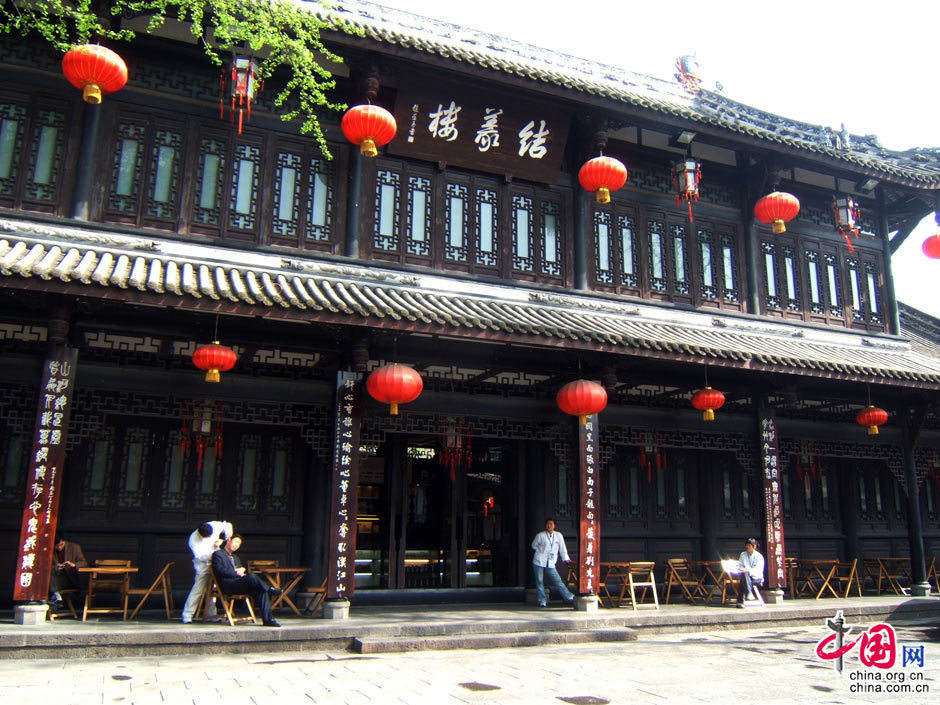
Chengdu city, located in southwestern China's Sichuan province, is known for its laid-back vibe. Jinli Street, downtown Chengdu's main commercial street, is the epitome of the leisurely way of life the city has come to be associated with. Illuminated by the red lanterns which decorate the antique shops and snack stalls lining the narrow flagstone pavement, Jinli is abuzz with life after nightfall. [China.org.cn]

Chengdu city, located in southwestern China's Sichuan province, is known for its laid-back vibe. Jinli Street, downtown Chengdu's main commercial street, is the epitome of the leisurely way of life the city has come to be associated with. Illuminated by the red lanterns which decorate the antique shops and snack stalls lining the narrow flagstone pavement, Jinli is abuzz with life after nightfall. [China.org.cn]
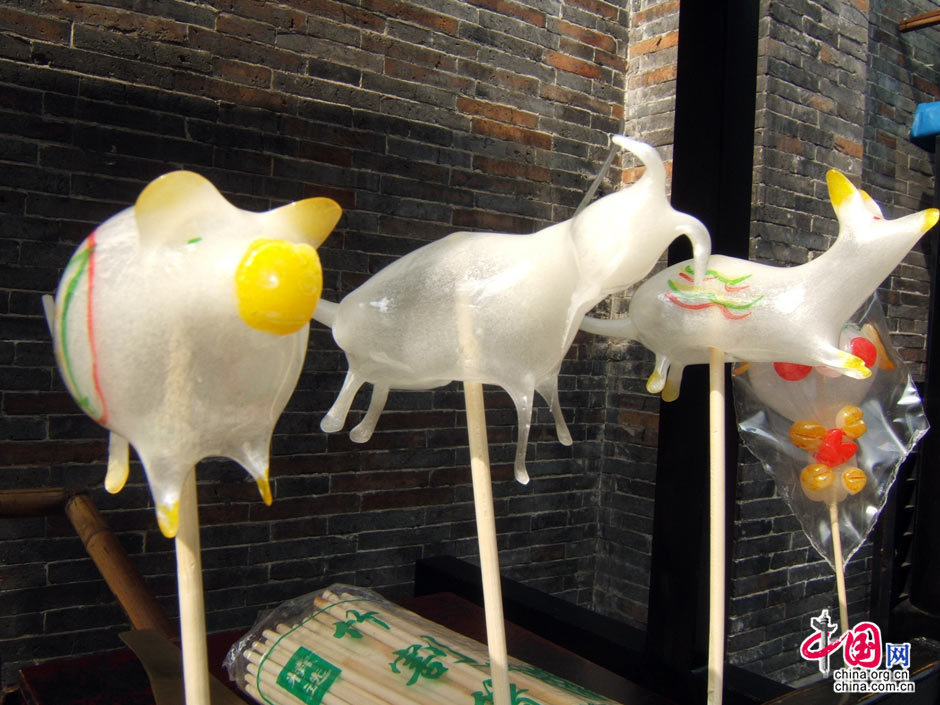
Chengdu city, located in southwestern China's Sichuan province, is known for its laid-back vibe. Jinli Street, downtown Chengdu's main commercial street, is the epitome of the leisurely way of life the city has come to be associated with. Illuminated by the red lanterns which decorate the antique shops and snack stalls lining the narrow flagstone pavement, Jinli is abuzz with life after nightfall. [China.org.cn]
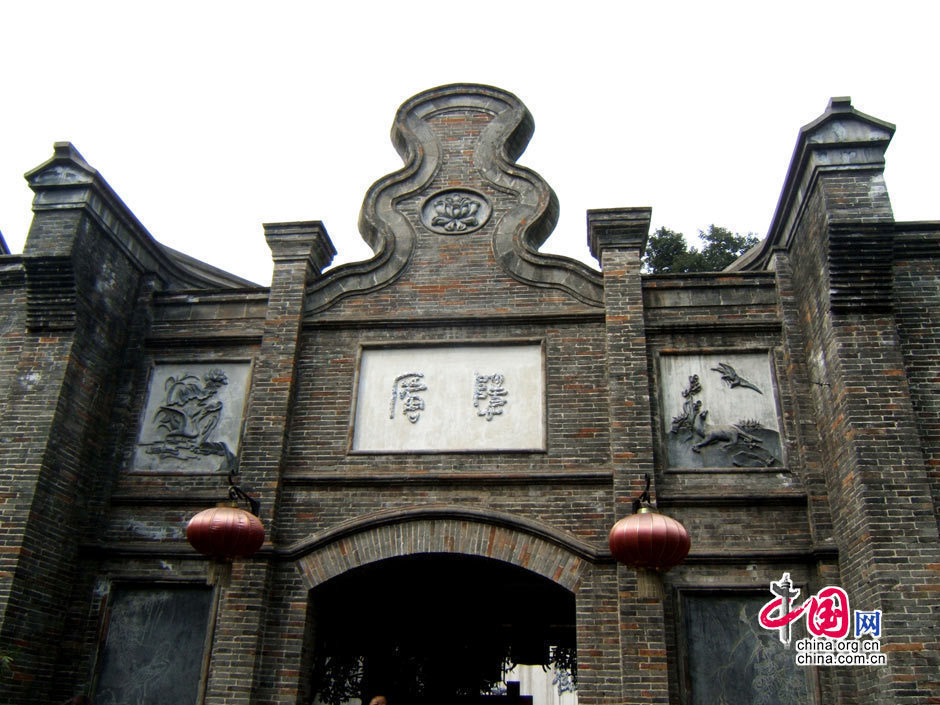
Chengdu city, located in southwestern China's Sichuan province, is known for its laid-back vibe. Jinli Street, downtown Chengdu's main commercial street, is the epitome of the leisurely way of life the city has come to be associated with. Illuminated by the red lanterns which decorate the antique shops and snack stalls lining the narrow flagstone pavement, Jinli is abuzz with life after nightfall. [China.org.cn]
China's Shenyang to offer 72-hour visa-free stays
SHENYANG, Nov. 25 (Xinhua) -- Shenyang, capital of northeast China's Liaoning Province, will launch 72-hour visa-free stays for foreign travelers next year, authorities said Monday.
From Jan. 1, 2014, travelers from 45 countries are expected to enjoy the policy, if they hold third country visas and have onward tickets to leave for a third country or region within 72 hours, according to the city's border control station.
The scheme will boost local tourism and bring in revenue, said a Shenyang tourism official.
More than 750,000 foreign tourists came to Shenyang last year, up 18 percent year on year, according to the city's tourism bureau. The figure is likely to increase after the visa policy takes effect, said the official.
So far, Beijing, Shanghai, Guangzhou, Chengdu and Chongqing have the 72-hour visa-free service in place. Dalian, a port city also in Liaoning Province, will launch the service on Jan. 1, 2014.
From Jan. 1, 2014, travelers from 45 countries are expected to enjoy the policy, if they hold third country visas and have onward tickets to leave for a third country or region within 72 hours, according to the city's border control station.
The scheme will boost local tourism and bring in revenue, said a Shenyang tourism official.
More than 750,000 foreign tourists came to Shenyang last year, up 18 percent year on year, according to the city's tourism bureau. The figure is likely to increase after the visa policy takes effect, said the official.
So far, Beijing, Shanghai, Guangzhou, Chengdu and Chongqing have the 72-hour visa-free service in place. Dalian, a port city also in Liaoning Province, will launch the service on Jan. 1, 2014.
Shanghai: Airport’s visa checks are fastest in world
BEIJING, Nov. 16 (Xinhuanet) -- Shanghai’s Pudong International Airport has the speediest visa checks of any major airport in the world, according to an industry body survey.
Airports Council International, a trade representative of the world’s airports, tested more than 100 major airports around the globe in the third quarter and ranked Pudong first in terms of “waiting time for visa check.”
Terminal 2 of the Pudong International Airport can open up to 47 channels and deal with 70 to 90 passengers in a minute.
Almost 70,000 passengers use the airport daily, with a record high of 95,000.
This is the first time for a domestic airport to top the ranking, Xinmin Evening News reported.
Beijing Capital International Airport had ranked second previously but this time dropped to third, its place taken by Seoul Incheon International Airport.
China has two more airports on the top 10 list. The Longjia International Airport in Changchun, capital of northeastern China’s Jilin Province, ranked fifth, followed by the Meilan International Airport in Haikou, capital of the southern island province Hainan.
The Pudong International Airport has been China’s mainland’s busiest airport for 10 years.
It has an advanced electronic system to monitor passenger flow, while batches of officers receive training every week.
Every quarter, ACI asks an institution to determine and review airports around the world, in a survey based on 36 standards, such as facilities and service.
(Source: Shanghai Daily)
Airports Council International, a trade representative of the world’s airports, tested more than 100 major airports around the globe in the third quarter and ranked Pudong first in terms of “waiting time for visa check.”
Terminal 2 of the Pudong International Airport can open up to 47 channels and deal with 70 to 90 passengers in a minute.
Almost 70,000 passengers use the airport daily, with a record high of 95,000.
This is the first time for a domestic airport to top the ranking, Xinmin Evening News reported.
Beijing Capital International Airport had ranked second previously but this time dropped to third, its place taken by Seoul Incheon International Airport.
China has two more airports on the top 10 list. The Longjia International Airport in Changchun, capital of northeastern China’s Jilin Province, ranked fifth, followed by the Meilan International Airport in Haikou, capital of the southern island province Hainan.
The Pudong International Airport has been China’s mainland’s busiest airport for 10 years.
It has an advanced electronic system to monitor passenger flow, while batches of officers receive training every week.
Every quarter, ACI asks an institution to determine and review airports around the world, in a survey based on 36 standards, such as facilities and service.
(Source: Shanghai Daily)
Nanjing Road: Centuries of shopping

The Nanjing Road Pedestrian Walkway is often full of shoppers, for its entire one kilometer length. [Photo: CRIENGLISH.com/William Wang]
Shanghai's reputation has long had a sharp focus on commerce and fashion. For anyone who wants to see the proof, go no further than Nanjing Road East. The stretch of pedestrian mall in particular is a touristy hive of consumerism. Store fronts and their barrage of neon lights battle over people's attentions, and window shoppers compete for space in the crowd. It is definitely one of China's shopping highlights, with up to a million shoppers daily.
Today, Nanjing Road is far from the epicenter of Shanghai's fashion scene, but it is the place that ushered that scene in. With a history that dates back to 1845, what started out as a few stores steadily grew into a center of commerce. By 1950, eight large department stores had arrived in Shanghai, each staking out a space along the avenue. The Shanghai No. 1 Department Store has held its ground since 1936, and has now grown to 11 stories.
Clothing and jewelry stores, restaurants and cafes all pull the throng towards and away from the Bund at the east end. International brand names are represented in full all along the road's length, with a smaller number of local outlets and eateries stubbornly clinging to their spots. To some, the scene feels familiar; it's a model that has been transplanted into many cities across China.
For anyone who wants to experience the Shanghai hustle and bustle, Nanjing Road East is a must-see. For actual shopping or dining, however, visitors can find better elsewhere. Nanjing Road has history, but history buffs will have to look pretty darn hard to see it.
And finally, a warning: Nanjing Road has the smell of money about it, and pickpockets often mingle in the throng. Scammers also are known to invite foreigners for coffee, eventually sticking them with a 5000 yuan bill.
Lalu Wetland National Nature Reserve in Lhasa
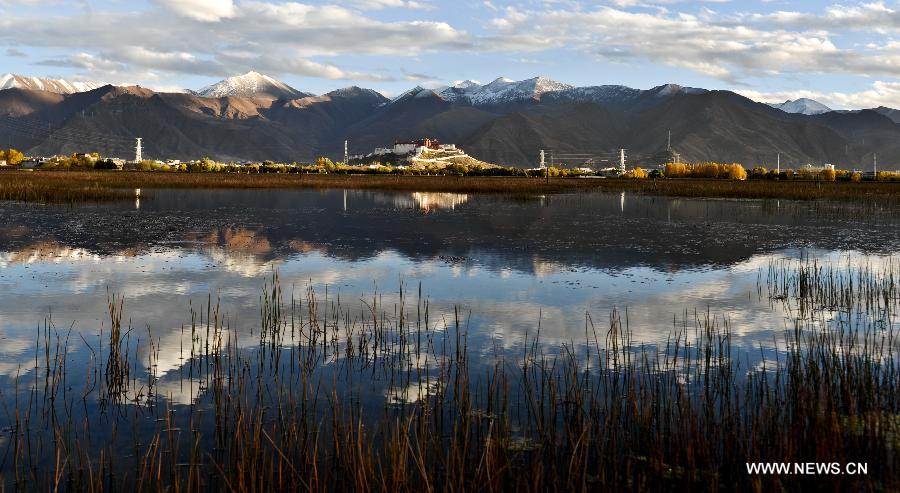
The Potala Palace is seenfrom the Lalu Wetland National Nature Reserve in Lhasa, capital of southwest China's Tibet Autonomous Region, Oct. 19, 2013. Local government is planning an investment of around 700 million yuan (115 million US dollars) to protect the Lalu Wetland, also called "the Lung of Lhasa", in which over 62 species of rare birds can be found. (Xinhua/Purbu Zhaxi)

Waterbirds fly in the Lalu Wetland National Nature Reserve in Lhasa, capital of southwest China's Tibet Autonomous Region, Dec. 4, 2013. Local government is planning an investment of around 700 million yuan (115 million US dollars) to protect the Lalu Wetland, also called "the Lung of Lhasa", in which over 62 species of rare birds can be found. (Xinhua/Purbu Zhaxi)
Chinese Zhusuan listed as World Intangible Cultural Heritage

The Zhusuan, otherwise known as the Chinese abacus was officially listed as an intangible cultural heritage at the 8th Annual UNESCO World Heritage Congress on December 4th in Baku, Azerbaijan. (Photo/Xinhua)
The Zhusuan, otherwise known as the Chinese abacus was officially listed as an intangible cultural heritage at the 8th Annual UNESCO World Heritage Congress on December 4th in Baku, Azerbaijan.
The abacus is an ancient calculating method with a history of over 2,500 years. It is regarded as the fifth invention in Chinese history and was listed as a national-level intangible cultural heritage in 2008.
The abacus’s popularity has been compromised over the course of time by the emergence of digital calculators; however, they are still in use in many of China’s rural marketplaces. Today, the abacus has a richer value as a cultural symbol rather than a practical calculating tool.
The UNESCO stated that intangible cultural heritage could bring a sense of identification to the people who own it and it is essential to maintaining cultural diversity and human creativity.
Since 2001, China has successfully applied for 37 items to be listed as World Intangible Cultural Heritages, including Kunqu opera, the shadow play and acupuncture.
China currently has 30 intangible cultural heritage items listed by UNESCO, the most among all countries throughout the world.
Facts about the abacus:
The Chinese abacus, also called suanpan, can be traced back to the Spring and Autumn Period (770-476BC).
It has two decks and more than seven rods. The upper deck, which is known as heaven, has two beads on each rod. These beads each have the value of five. There are five beads on the bottom deck, known as earth. Each of these has the value of one. The beads are moved up and down during calculation.

A group of students were shown a mega-abacus in Zhongshan city, Guangdong province. (Photo/Xinhua)
Hui'an, home of stone carving
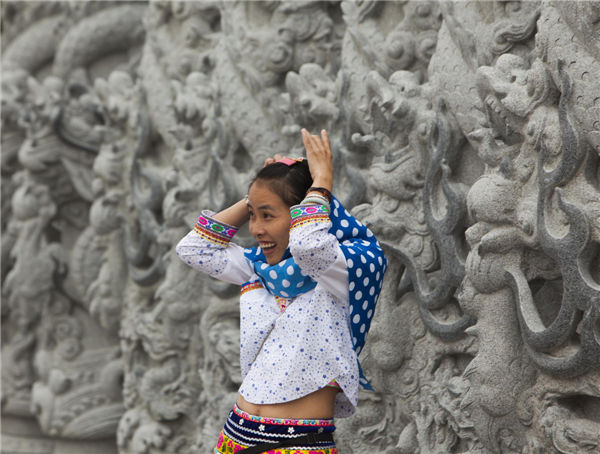
A girl stands in front of a stone sculpture in Hui'an county, Fujian province, December 8, 2013. [Photo/Xinhua]
Hui'an stone carving has enjoyed a long history spanning over 1,600 years, and boasts various engraving techniques.
The craft was listed within the first group of national intangible cultural heritages in 2006, and Hui'an county was honored as "The hometown of Chinese folk art (sculpture)".
Today, the number of people working in the stone carving industry is around 100,000, creating an annual industry output value of 15 billion yuan.

Stone carving sculptures displayed in Hui'an county, Fujian province, December 8, 2013. [Photo/Xinhua]
High-speed services added to schedule
High-speed services connecting the Yangtze River Delta Region and the northeast will open on Dec 28, reducing the travel time from Shanghai to Harbin, the farthest provincial capital in Northeast China, to less than 13 hours.
The trip used to take 22 hours.
High-speed trains will run between Shanghai's Hongqiao Station and big cities in the northeast: Harbin, Changchun, Shenyang and Dalian, according to Shanghai Railway Bureau, and also between Ningbo, Zhejiang province, and Shenyang.
All of the trains will set off in the morning and run during the daytime.
High-speed trains will also start their maiden trips between Shenzhen, Guangdong province, and Shanghai, Nanjing, Hangzhou and Wenzhou. It will take around 10 hours to travel from Shanghai to Shenzhen.
Altogether, 68 train services will operate on the new schedule.
High-speed rail tickets from Shanghai to the northeastern cities of Harbin, Changchun and Shenyang can be booked by phone or on the Internet starting on Monday, the bureau said.
Although ticket prices have not been published, the news of the upcoming high-speed railway operation has led to a drop in airline ticket prices.
The price of airline tickets from Shanghai to cities in the northeast is down 80 percent around Dec 28 and about 60 percent on Jan 10, three weeks before Spring Festival, when hundreds of millions of people will travel back home.
The trip used to take 22 hours.
High-speed trains will run between Shanghai's Hongqiao Station and big cities in the northeast: Harbin, Changchun, Shenyang and Dalian, according to Shanghai Railway Bureau, and also between Ningbo, Zhejiang province, and Shenyang.
All of the trains will set off in the morning and run during the daytime.
High-speed trains will also start their maiden trips between Shenzhen, Guangdong province, and Shanghai, Nanjing, Hangzhou and Wenzhou. It will take around 10 hours to travel from Shanghai to Shenzhen.
Altogether, 68 train services will operate on the new schedule.
High-speed rail tickets from Shanghai to the northeastern cities of Harbin, Changchun and Shenyang can be booked by phone or on the Internet starting on Monday, the bureau said.
Although ticket prices have not been published, the news of the upcoming high-speed railway operation has led to a drop in airline ticket prices.
The price of airline tickets from Shanghai to cities in the northeast is down 80 percent around Dec 28 and about 60 percent on Jan 10, three weeks before Spring Festival, when hundreds of millions of people will travel back home.
First Temple of Beijing - Tanzhe Temple

Located at the foot of Tanzhe Mountain in Mentougou district, Tanzhe Temple is one of the well known Buddhist temples in Beijing. The temple was built along the mountain contours. Most buildings in the temple were built in the Ming (1368-1644) and Qing (1644-1911) dynasties. There are also many pagodas from various dynasties such as the Jin (1115–1234) and Yuan (1279–1368). [Photo by Yu Jiaqi]
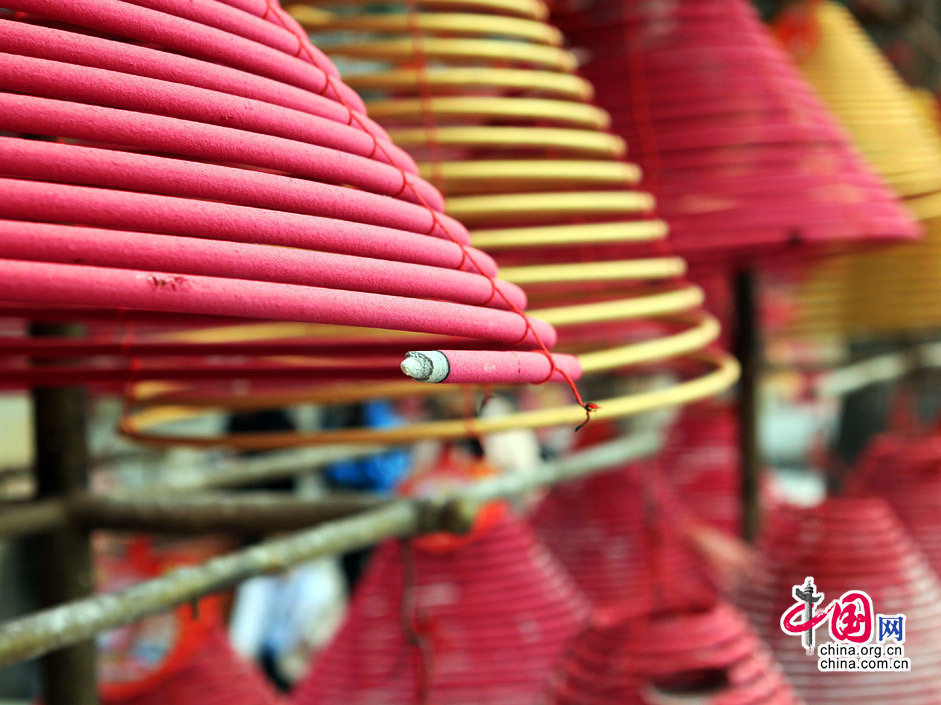
Located at the foot of Tanzhe Mountain in Mentougou district, Tanzhe Temple is one of the well known Buddhist temples in Beijing. The temple was built along the mountain contours. Most buildings in the temple were built in the Ming (1368-1644) and Qing (1644-1911) dynasties. There are also many pagodas from various dynasties such as the Jin (1115–1234) and Yuan (1279–1368). [Photo by Yu Jiaqi]
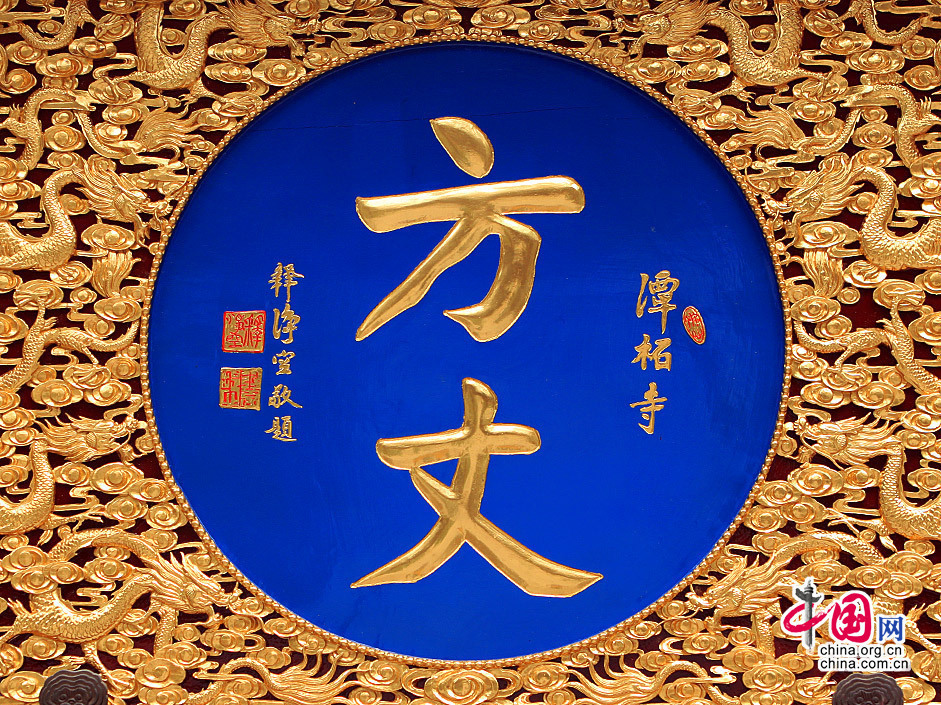
Located at the foot of Tanzhe Mountain in Mentougou district, Tanzhe Temple is one of the well known Buddhist temples in Beijing. The temple was built along the mountain contours. Most buildings in the temple were built in the Ming (1368-1644) and Qing (1644-1911) dynasties. There are also many pagodas from various dynasties such as the Jin (1115–1234) and Yuan (1279–1368). [Photo by Yu Jiaqi]

Located at the foot of Tanzhe Mountain in Mentougou district, Tanzhe Temple is one of the well known Buddhist temples in Beijing. The temple was built along the mountain contours. Most buildings in the temple were built in the Ming (1368-1644) and Qing (1644-1911) dynasties. There are also many pagodas from various dynasties such as the Jin (1115–1234) and Yuan (1279–1368). [Photo by Yu Jiaqi]
Subscribe to:
Posts (Atom)